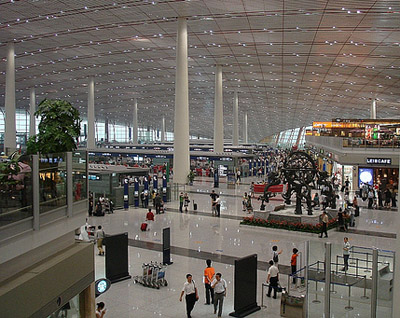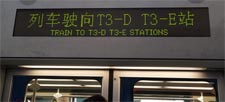Beijing’s new airport express train can transport Olympics spectators downtown in just 20 minutes.
The Beijing
Capital International Airport (BCIA) is the largest airport inAsia and home to the largest airport terminal in the world
– Terminal 3. Built for the Olympic
Games and the 1,500 flights expected to arrive and depart in the three days
before and after the games, Terminal 3 cost approximately $3.8 billion and
extends 1.8 miles from end to end. At 14 million sq. ft., it took 50,000 workers
four years to complete the terminal, which covers an area twice the size of the
Pentagon.

Photo Courtesy of Don
Kong
Beijing expects its airport to accommodate
more than five million people during the Olympic Games. But once they’ve landed
and picked up their luggage, millions of additional cars on Beijing’s extremely
congested streets and highways would bring the city to a halt. To accommodate all of these travelers,
the city built a 12-mile light rail airport express line from BCIA to downtown
Beijing. For about $3, passengers will arrive at their
destination in 20 minutes. While the train only makes three stops, Chinese
officials printed the route on the back of every fare card, installed video
monitors in the rail cars, and provided real-time displays to help international
travelers navigate their system.

Photo Courtesy of Rudeeporn
Somjit
Cities that cater to large
international audiences benefit from a welcoming and user-friendly
transportation system that moves visitors quickly to their destinations. In addition to Beijing, cities such as Stockholm, London and
Tokyo offer
their visitors an express train from the airport to the city. These cities know
that confusing signage, too many stops, and complicated connections can
discourage the traveler from using transit and opt for a cab or rental car
instead – adding more traffic to a city’s already congested conditions.
Here in Chicago, public transit connects downtown Chicago with its two
international airports, Midway and O’Hare.
However, getting to O’Hare only 17 miles away from the city center, takes
almost an hour via the CTA Blue Line.
The Orange Line from Midway transports passengers 11 miles and takes over
30 minutes to get to downtown Chicago.
The city has proposed a direct airport express train that would cut
travel times to and from the heart of the city, allow for passengers to check-in
before even stepping into the airport, and affirm Chicago’s position as a
leading international city. As
Chicago continues to build its case to host the
2016 Olympic Games – like Beijing, improvements include the modernization
of O’Hare Airport – the city has the opportunity to improve its transit
infrastructure by providing quick and convenient options to move millions of
visitors between our airports and downtown. While an infusion of capital money from
forthcoming state and federal infrastructure bills would help move Chicago's
airport express dream forward, a public-private partnership, such as the ones
that built and operate the airport express services for London and Stockholm, is
needed to make the dream a reality.
This article was featured in Talking
Transit, MPC’s bi-weekly e-newsletter. To receive the newsletter, email talkingtransit@metroplanning.org
with ‘Subscribe’ in the subject line.